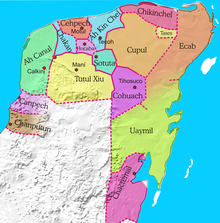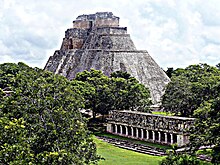Tutul Xiu (dynasty)
Tutul Xiu , only Xiu or Tutul XIW , is the name of a post-classical princely family of the Maya of Yucatan . The family continues to the present day.
history
According to indigenous traditions, the homeland of the Tultul Xiu is considered to be the coastal land of Tabasco , from where they immigrated to Yucatán under the leadership of Holon Ch'an Tepehu . In 928 they are said to have expelled the Itzá from Chakán Putum , possibly even residing in Chichén Itzá itself and are said to have finally founded the city of Uxmal under the leadership of Ah Cuitok Tutul Xiu alias Hun Uitzil Chac . The Tutul Xiu are also said to have belonged to the so-called League of Mayapán .
Neither archaeological findings nor ancient American studies have so far been able to support this information, even if there is actually little doubt about the rule of the Tutul Xiu over the area of Uxmal.
When Uxmal was abandoned, the Tutul Xiu are said to have moved their residence to Maní , where they have had a family seat until recently. a. also residences in Panabchen, Ticit, Yacaman or Yaxa. The principality they ruled was also called Tutul Xiu.
Under Ah Xupan Xiu , the Halach Huinik of Maní , the Maya rose from 1441 to 1461 in an uprising against the dominance of the Cocom . The coup was successful and led to the almost complete extinction of the Cocom and the destruction of Ich Paa . As a result, 16 principalities ( Mayathan : cuchcabal ) established themselves in Yucatán, as they were still encountered by the Spaniards with whom the Tutul Xiu allied. At that time, the Tutul Xiu were one of the most powerful families among the Mayan princes and ruled over one of the largest jurisdictions. Another consequence, which lasted until the time of the Spanish conquest, was a deep hostility with the Cocom, which was also fought as a war. The latter led the resistance against the Spaniards at times. In 1536, a group of pilgrims from the Xiu family who wanted to make sacrifices at the sacred cenote of Chichén Itzá for an end to a drought period are said to have been killed by the Cocom in their sleep.
Between December 25, 1557 and January 6, 1558, Alonso Ortiz de Argueta, the Spanish governor in Yucatán, received homage from Francisco Montejo Xiu from Maní as a representative of his family on the occasion of Philip II's accession to the throne . In the 16th century, his great-nephew Don Pedro Xiu held the position of Batab from Tekax .
Trunk line
- Hun Uitzil Chac Tutul Xiuh, ∞ Ix (...) from Ticul
- Ah Dzun Xiu
- Ah Op Xiu
- Nappol Chuuah Xiu
- Ah Çiyah Xiu, ruler of Yacaman, († 1536)
- (Ah Kukil) Francisco Montejo Xiu , last Halach Huinik of Maní , allied with Montejo in 1542 , then governor of Maní († after 1557), ∞ Doña María Xiu su
- Ah Çiyah Xiu, ruler of Yacaman, († 1536)
- Nappol Chuuah Xiu
- Ah Cetz Xiu
- Ah Kukil Xiu
- Don Diego Xiu, governor of Tikit in 1581
- Ah Kukil Xiu
- Ah Uitz Xiu
- Ah Tzam (Itzam) Xiu
- Don Juan Xiu
- Doña María Xiu, Calotmul, ∞ Francisco de Montejo Xiu so
- Don Juan Xiu
- Ah Tzam (Itzam) Xiu
- Ah Kauil Xiu
- Ah Lol Xiu
- Ah Dzulub Xiu, Viavelo de Don Francisco Pacab, Qxkutzcab
- Ix Kukil Xiu, mother of Gaspar Antonio Chi
- Ah Dzulub Xiu, Viavelo de Don Francisco Pacab, Qxkutzcab
- Ah Lol Xiu
- Ah Op Xiu
- Ah Uitz Xiu
- Ah Cuat Xiu
- Ah Atti (r) a Xiu
- Nabatun Xiu, ( ca.1540 Batab of Panabche'en)
- Don Alonso Xiu, 1557–1572 governor of Tikit
- Nabatun Xiu, ( ca.1540 Batab of Panabche'en)
- Ah Atti (r) a Xiu
- Ah Cuat Xiu
- Ah Dzun Xiu
literature
- Diego de Landa : Relacion de las cosas de Yucatán. P. 12–29 online version, Spanish (PDF; 513 kB)
- Berthold Riese : The Maya: History, Culture, Religion. Munich 2006, pp. 102, 104, 112-113, 120; ISBN 3-406-46264-2
- Ralph L. Roys : The Political Geography of the Yucatan Maya. Washington 1957, pp. 62-77
- Miloslav Stingl : Indians before Columbus. Leipzig • Jena • Berlin 1982, pp. 219, 223
Individual evidence
- ↑ Chilam Balam
- ↑ Cronica de Oxkutzcab from 1538
- ^ Raúl Casares G. Cantón, Juan Duch Colell, Michel Antochiw Kolpa, Silvio Zavala Vallado, et al: Yucatán en el tiempo. Mérida 1998 (Spanish)
Web links
- The Xiu in the 16th century (Spanish)


